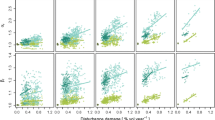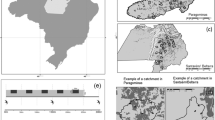Abstract
Context
Despite decades of research, there is an intense debate about the consistency of the hump-shaped pattern describing the relationship between diversity and disturbance as predicted by the intermediate disturbance hypothesis (IDH). Previous meta-analyses have not explicitly considered interactive effects of disturbance frequency and intensity of disturbance on plant species diversity in terrestrial landscapes.
Objective
We conducted meta-analyses to test the applicability of IDH by simultaneously examining the relationship between species richness, disturbance frequency (quantified as time since last disturbance as originally proposed) and intensity of disturbance in forest landscapes.
Methods
The effects of disturbance frequency, intensity, and their interaction on species richness was evaluated using a mixed-effects model.
Results
We found that species richness peaks at intermediate frequency after both high and intermediate disturbance intensities, but the richness-frequency relationship differed between intensity classes.
Conclusions
Our study highlights the need to measure multiple disturbance components that could help reconcile conflicting empirical results on the effect of disturbance on plant species diversity.


Similar content being viewed by others
References
Attiwill PM (1994) The disturbance of forest ecosystems—the ecological basis for conservative management. For Ecol Manag 63(2–3):247–300
Barnosky AD, Matzke N, Tomiya S, Wogan GO, Swartz B, Quental TB, Marshall C, McGuire JL, Lindsey EL, Maguire KC, Mersey B (2011) Has the Earth’s sixth mass extinction already arrived? Nature 471(7336):51–57
Bates D, Maechler M, Bolker B, Walker S (2013) lme4: linear mixed-effects models using Eigen and S4. R Package Version 1(4)
Bongers F, Poorter L, Hawthorne WD, Sheil D (2009) The intermediate disturbance hypothesis applies to tropical forests, but disturbance contributes little to tree diversity. Ecol Lett 12(8):798–805
Brown KA, Gurevitch J (2004) Long-term impacts of logging on forest diversity in Madagascar. Proc Natl Acad Sci USA 101(16):6045–6049
Chase JM, Leibold MA (2002) Spatial scale dictates the productivity-biodiversity relationship. Nature 416(6879):427–430
Clark DF, Antos JA, Bradfield GE (2003) Succession in sub-boreal forests of west-central British Columbia. J Veg Sci 14(5):721–732
Clark JA, Covey KR (2012) Tree species richness and the logging of natural forests: a meta-analysis. For Ecol Manag 276:146–153
Collins B, Wein G, Philippi T (2001) Effects of disturbance intensity and frequency on early old-field succession. J Veg Sci 12(5):721–728
Connell JH (1978) Diversity in tropical rain forests and coral reefs. Science 199(4335):1302–1310
Cooke BJ, Roland J (2007) Trembling aspen responses to drought and defoliation by forest tent caterpillar and reconstruction of recent outbreaks in Ontario. Can J For Res 37(9):1586–1598
Edwards DP, Laurance WF (2013) Biodiversity despite selective logging. Science 339(6120):646–647
Edwards FA, Edwards DP, Hamer KC, Davies RG (2013) Impacts of logging and conversion of rainforest to oil palm on the functional diversity of birds in Sundaland. Ibis 155(2):313–326
Hall AR, Miller AD, Leggett HC, Roxburgh SH, Buckling A, Shea K (2012) Diversity-disturbance relationships: frequency and intensity interact. Biol Lett 8(5):768–771
Hedges LV, Gurevitch J, Curtis PS (1999) The meta-analysis of response rations in experimental ecology. Ecology 80(4):1150–1156
Huston M (1979) General hypothesis of species-diversity. Am Nat 113(1):81–101
Ilisson T, Chen HYH (2009) Response of six boreal tree species to stand replacing fire and clearcutting. Ecosystems 12(5):820–829
Keddy P (2005) Putting the plants back into plant ecology: six pragmatic models for understanding and conserving plant diversity. Ann Bot 96(2):177–189
Kershaw HM, Mallik AU (2013) Predicting plant diversity response to disturbance: applicability of the intermediate disturbance hypothesis and mass ratio hypothesis. Crit Rev Plant Sci 32(6):383–395
Kondoh M (2001) Unifying the relationships of species richness to productivity and disturbance. Proc R Soc B 268(1464):269–271
Mackey RL, Currie DJ (2001) The diversity-disturbance relationship: is it generally strong and peaked? Ecology 82(12):3479–3492
Mayor SJ, Cahill JF Jr, He F, Solymos P, Boutin S (2012) Regional boreal biodiversity peaks at intermediate human disturbance. Nat Commun 3:1142
Miller A, Reilly D, Bauman S, Shea K (2012) Interactions between frequency and size of disturbance affect competitive outcomes. Ecol Res 27(4):783–791
Miller AD, Roxburgh SH, Shea K (2011) How frequency and intensity shape diversity-disturbance relationships. Proc Natl Acad Sci USA 108(14):5643–5648
Miller TE (1982) Community diversity and interactions between the size and frequency of disturbance. Am Nat 120(4):533–536
Mitchell-Olds T, Shaw RG (1987) Regression analysis of natural selection: statistical inference and biological interpretation. Evolution 1:1149–1161
Mittelbach GG, Steiner CF, Scheiner SM, Gross KL, Reynolds HL, Waide RB, Willig MR, Dodson SI, Gough L (2001) What is the observed relationship between species richness and productivity? Ecology 82(9):2381–2396
Moloney KA, Levin SA (1996) The effects of disturbance architecture on landscape-level population dynamics. Ecology 77(2):375–394
Paine RT, Tegner MJ, Johnson EA (1998) Compounded perturbations yield ecological surprises. Ecosystems 1(6):535–545
R Development Core Team (2014) R: a language and environment for statistical computing. Version 3.1.0. version 3.1.0 edn. R Foundation for Statistical Computing, Vienna, Austria
Rosenzweig ML (1995) Species diversity in space and time. Cambridge University Press, Cambridge
Schweitzer CJ, Dey DC (2011) Forest structure, composition, and tree diversity response to a gradient of regeneration harvests in the mid-Cumberland Plateau escarpment region, USA. For Ecol Managment 262(9):1729–1741
Shea K, Roxburgh SH, Rauschert ESJ (2004) Moving from pattern to process: coexistence mechanisms under intermediate disturbance regimes. Ecol Lett 7(6):491–508
Sousa WP (1984) The role of disturbance in natural communities. Annu Rev Ecol Syst 15(1):353–391
Svensson JR, Lindegarth M, Jonsson PR, Pavia H (2012) Disturbance-diversity models: what do they really predict and how are they tested? Proc R Soc B 279(1736):2163–2170
Taylor AR, Chen HYH (2011) Multiple successional pathways of boreal forest stands in central Canada. Ecography 34(2):208–219
Taylor AR, Hart T, Chen HYH (2013) Tree community structural development in young boreal forests: a comparison of fire and harvesting disturbance. For Ecol Manag 310:19–26
Viechtbauer W (2010) Conducting meta-analyses in R with the metafor package. J Stat Softw 36(3):1–48
Vitousek PM, Mooney HA, Lubchenco J, Melillo JM (1997) Human domination of earth’s ecosystems. Science 277(5325):494–499
Zhang Y, Chen HYH, Taylor AR (2014) Multiple drivers of plant diversity in forest ecosystems. Glob Ecol Biogeogr 23(8):885–893
Acknowledgments
The study was funded by the Ontario Government of Canada through the Ontario Trillium Scholarship (OTS) for a doctoral research and Natural Sciences and Engineering Research Council of Canada (DG283336-09). We thank Patrick Gauthier, Gabriel Danyagri, Samuel Bartels, Chander Shahi and Kevin Crowe for their comments and editorial assistance.
Author information
Authors and Affiliations
Corresponding author
Electronic supplementary material
Below is the link to the electronic supplementary material.
Rights and permissions
About this article
Cite this article
Yeboah, D., Chen, H.Y.H. Diversity–disturbance relationship in forest landscapes. Landscape Ecol 31, 981–987 (2016). https://doi.org/10.1007/s10980-015-0325-y
Received:
Accepted:
Published:
Issue Date:
DOI: https://doi.org/10.1007/s10980-015-0325-y




